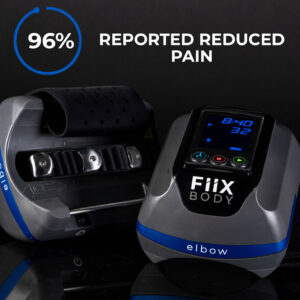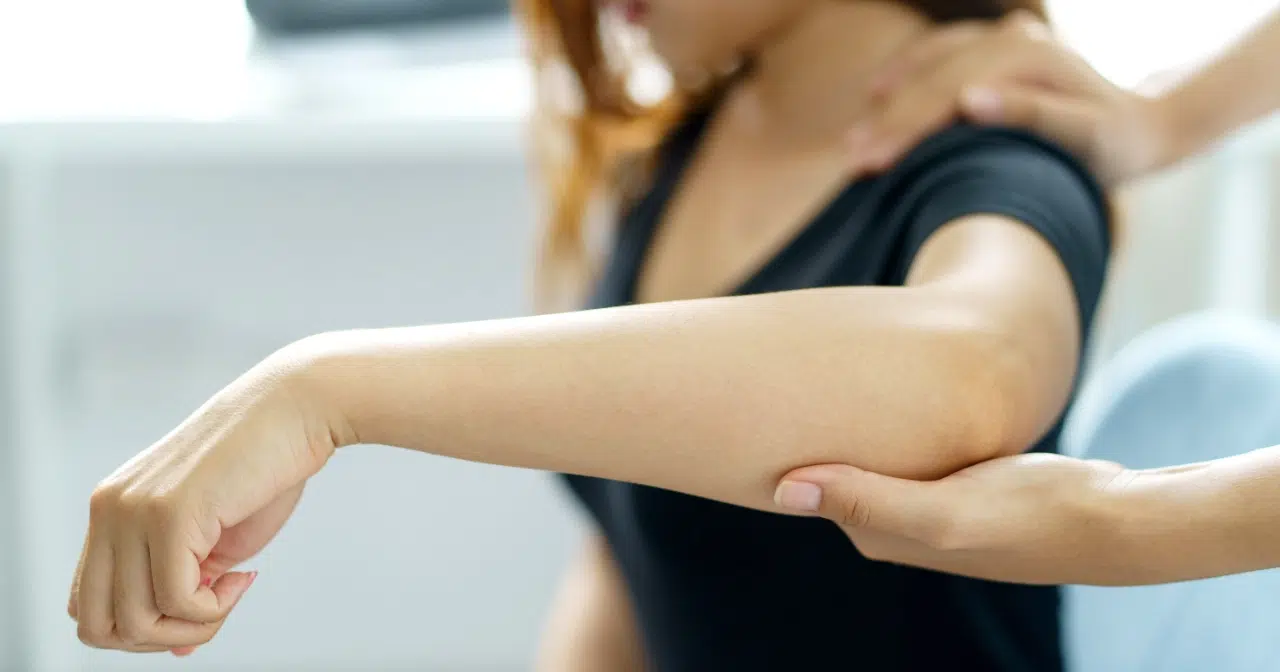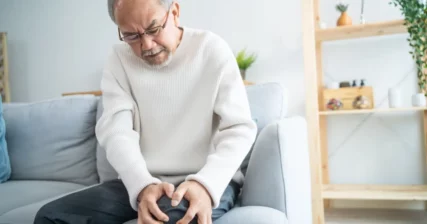Listen on: Apple Podcasts | Spotify
A little while back, I wrote an article about tennis elbow, leading to many more emails and direct messages than I expected. I guess it’s more common among my readers than I realized. Undoubtedly, its close cousin, Golfer’s Elbow, is equally common. It’s also just as painful and stems from a similar cause. And, just like tennis elbow isn’t just a tennis-playing issue, golfer’s elbow doesn’t affect only golfers.
About a week after I wrote How to Treat Tennis Elbow Fast: Exercises, Supplements, and Therapies, I connected with the founder of Fiix Body, who told me about a device he created that’s as effective as the best physical therapy, and which you can do from home.
I was intrigued. He offered to send me one to try. Coincidentally, a couple of days later, I started showing signs of golfer’s elbow. That was about a month ago, and my golfer’s elbow has progressively worsened. However, I didn’t want to open my Fiix Body box until my golfer’s elbow had gotten severe, as I wanted to give it a serious trial. I opened the box today and started using it.
I figured it was time to not only write about golfer’s elbow and its symptoms and causes, but also time to highlight the research-supported benefits of Fiix Body. Oh, and I’ve got some great news for you, too. The team at Fiix Body hooked me up with a special discount for my readers. You can get $100 off the device when you use my link, and it comes with a 90-day money-back guarantee! That blew my mind the most. You can try it seriously, and if you don’t find relief in a couple of months of regular use, you can get your money back.
Let’s get on with this article and help you eliminate golfer’s elbow.
What is golfer’s elbow?
Golfer’s elbow, or medial epicondylitis, is a condition characterized by pain and inflammation on the inner side of your elbow, where the tendons of your forearm muscles attach to the bony bump (epicondyle). It’s typically caused by damage to the tendons and muscles due to overuse or repetitive motion. While the name may suggest it’s exclusive to golfers, it definitely isn’t. It can affect anyone who engages in activities that strain the forearm muscles.
Speaking of activities, certain resistance training exercises can inadvertently exacerbate golfer’s elbow if not executed with proper form. Wrist curls, reverse wrist curls, forearm pronation and supination exercises, and pull-up or chin-up movements may worsen the condition, particularly if you’re not careful with the weights you’re lifting or your technique.1Peterson M, Butler S, Eriksson M, Svärdsudd K. A randomized controlled trial of exercise versus wait-list in chronic tennis elbow (lateral epicondylosis). Ups J Med Sci. 2011 Nov;116(4):269-79. doi: 10.3109/03009734.2011.600476.
It sounds similar to tennis elbow, and in some ways, it is, but the underlying cause is different in each. While both involve inflammation of the tendons in the elbow due to overuse, tennis elbow affects the outer part of the elbow rather than the inside.2Shiri R, Viikari-Juntura E. Lateral and medial epicondylitis: role of occupational factors. Best Pract Res Clin Rheumatol. 2011 Feb;25(1):43-57. doi: 10.1016/j.berh.2011.01.013. The distinction between the two conditions is crucial for accurate diagnosis and effective treatment.
Symptoms of golfer’s elbow usually include pain and tenderness on the inside, stiffness, weakness in the hands and wrists, and a tingling or numbing sensation radiating into one or more fingers, usually the ring and little fingers.3Herquelot E, Guéguen A, Roquelaure Y, Bodin J, Sérazin C, Ha C, et al. Work-related risk factors for incidence of lateral epicondylitis in a large working population. Scand J Work Environ Health. 2013 Nov;39(6):578-88. doi: 10.5271/sjweh.3371. Epub 2013 Jun 26. The pain might flare up during activities that involve gripping or bending the wrist toward the forearm or while doing those specific resistance exercises mentioned earlier.
Whether you’re an avid golfer, a gym enthusiast, or your job involves repetitive hand and wrist movements, golfer’s elbow can affect you. And trust me, it’s worth understanding the ins and outs of this condition.
How to Diagnose Golfer’s Elbow
When you visit your healthcare provider with the symptoms above, they’ll likely begin with a physical examination. They’ll check for pain or tenderness in different parts of your arm, ask you to move your elbow, wrist, and fingers in specific ways, and apply some pressure to the affected area.4Ciccotti MG, Schwartz MA, Ciccotti MC. Diagnosis and treatment of medial epicondylitis of the elbow. Clin Sports Med. 2004 Oct;23(4):693-705, ix-x. doi: 10.1016/j.csm.2004.04.012.
You might wonder, “Why can’t they just take a look at an X-ray and tell you what’s wrong?” Although X-rays can rule out other conditions, such as fractures or arthritis, they might not always show the soft tissue injuries typically seen in golfer’s elbow.5Faro F, Wolf JM. Lateral epicondylitis: review and current concepts. J Hand Surg Am. 2007 Oct;32(8):1271-9. doi: 10.1016/j.jhsa.2007.07.019. Therefore, your healthcare provider might use a combination of physical examination, your description of symptoms, and possibly other diagnostic tests like MRI or ultrasound scans, to make a definitive diagnosis.6Behrens SB, Deren ME, Matson AP, Bruce B, Green A. A review of modern management of lateral epicondylitis. Phys Sportsmed. 2012 May;40(2):34-40. doi: 10.3810/psm.2012.05.1968.
While a self-diagnosis might seem tempting, remember that several conditions can mimic golfer’s elbow symptoms. These can range from nerve entrapments, like cubital tunnel syndrome, to more severe conditions like elbow joint arthritis or even a heart problem.7Vicenzino B, Cleland JA, Bisset L. Joint manipulation in the management of lateral epicondylalgia: a clinical commentary. J Man Manip Ther. 2007;15(1):50-6. doi: 10.1179/106698107790819873. PMID: 19066664; PMCID: PMC2565076. You should probably see a doctor if you’re sedentary and have developed golfer’s elbow symptoms. However, if you’ve been more physically active than normal or have been doing activities that are different than normal (like building a chicken coop and run and a deck while doing other landscaping and yard work this summer as I have been), there’s a good chance that it’s golfer’s elbow.
Conventional Treatments for Golfer’s Elbow
Once you’ve secured a professional diagnosis of golfer’s elbow, the next step is addressing the condition head-on. The primary goal is to alleviate pain, reduce inflammation, promote healing, and, ultimately, get you back to your usual activities sans discomfort.
Let’s start with the conventional treatments – these are often the first line of defense.
- Rest: Sounds simple, right? But for some, it’s easier said than done. I’m probably the last person who would stop activity unless it was a severe emergency. Taking a break from activities that cause pain, whether that’s golfing, weightlifting, or even certain work tasks, can significantly help in the healing process, but you might not need to if you take advantage of some of these other options.
- Physical Therapy: Special exercises, guided by a physiotherapist, can help strengthen your forearm muscles, improve flexibility, and promote healing. This approach can be remarkably effective in managing golfer’s elbow.8Peterson M, Butler S, Eriksson M, Svärdsudd K. A randomized controlled trial of eccentric vs. concentric exercise in chronic tennis elbow. Clin Rehabil. 2014 Oct;28(10):1058-67. doi: 10.1177/0269215514534862. They may also perform a type of manual therapy called Graston. The therapist uses an instrument to apply enough pressure to cause micro trauma to the connective tissue, stimulating stem cell production and new collagen synthesis. Unfortunately, with people’s busy schedules, a patient can rarely get in often enough for the therapy to be effective.
- Medications: Over-the-counter nonsteroidal anti-inflammatory drugs (NSAIDs) like ibuprofen can help reduce pain and inflammation. Of course, regular use carries serious risks, so if you don’t need to take an NSAID, don’t take it.9Bisset L, Beller E, Jull G, Brooks P, Darnell R, Vicenzino B. Mobilisation with movement and exercise, corticosteroid injection, or wait and see for tennis elbow: randomised trial. BMJ. 2006 Nov 4;333(7575):939. doi: 10.1136/bmj.38961.584653.AE.
- Braces or Straps: Your doctor might recommend wearing a brace or strap around your forearm to help reduce strain on the injured tissue.
But what if conventional treatments aren’t helping? For more severe cases, there are a few other treatments available.
- Cortisone Injections: These injections can help reduce inflammation and pain. However, they’re not typically a long-term solution and should be administered judiciously due to potential side effects.10Coombes BK, Bisset L, Brooks P, Khan A, Vicenzino B. Effect of corticosteroid injection, physiotherapy, or both on clinical outcomes in patients with unilateral lateral epicondylalgia: a randomized controlled trial. JAMA. 2013 Feb 6;309(5):461-9. doi: 10.1001/jama.2013.129.
- Surgery: In rare cases, if your symptoms do not improve after a reasonable period of conservative treatments, your doctor may suggest surgery to remove damaged tissue. This is usually followed by a rehabilitation program to help restore function.11Nirschl RP, Ashman ES. Elbow tendinopathy: tennis elbow. Clin Sports Med. 2003 Oct;22(4):813-36. doi: 10.1016/s0278-5919(03)00037-0.
For the most part, conventional treatment relieves some pain but doesn’t fix the underlying issues. This is where the Fiix Elbow device by Fiix Body comes in.
The Fiix Elbow by Fiix Body
One type of manual therapy, known as linear, deep tissue massage, gets great results in treating tennis or golfer’s elbow. The biggest problem with getting results is getting people to show up for their chiropractic or physical therapy appointments consistently.
A small group of people, including sports physical therapists, looked for a way to get people the treatment they needed without needing to visit a clinic. They invented the Fiix Elbow device from Fiix Body.
The Fiix Elbow uses patented technology to automate a linear deep tissue massage, a proven therapy method. Fiix Elbow Device helps release scar tissue, smooth fascia and connective tissue, and increase blood flow, helping your body to naturally heal the tendon and tissues that are responsible for your elbow pain.
Fiix Body
As I mentioned at the beginning of this article, I received a Fiix Elbow and began the treatment process recently. Though the treatment can be quite painful, I was familiar with the pain from my experience with similar treatment following my biceps tendon rupture and my broken neck.
The device is designed to break down scar tissue and adhesions, so the process isn’t pleasant, but neither is the constant pain of golfer’s or tennis elbow.
The treatment gets results.

If you have tennis elbow or golfer’s elbow, I strongly recommend ordering the Fiix Elbow. The Fiix Body team extended a $100 discount for my readers, and it comes with an incredible 90-Day Money Back Guarantee!
Extra Golfer’s Elbow Relief from Supplements and Essential Oils
Although no magic pill can cure golfer’s elbow, some dietary supplements and essential oils can reduce inflammation, improve tissue healing, and support your overall recovery. The following are among the most likely to provide relief and improve recovery.
Supplements
- Omega-3 fatty acids: Known for their anti-inflammatory properties, omega-3 fatty acids may help reduce inflammation associated with golfer’s elbow. They can be found in fish oil supplements or in foods like fatty fish, chia seeds, flaxseeds, and walnuts, although I recommend getting your omega-3s from animal sources more than plant-based sources.12Gammone MA, Riccioni G, Parrinello G, D’Orazio N. Omega-3 Polyunsaturated Fatty Acids: Benefits and Endpoints in Sport. Nutrients. 2018 Dec 27;11(1):46. doi: 10.3390/nu11010046.
- Collagen: As the primary protein in tendons, collagen supplementation could potentially support tendon health. Studies have shown that collagen supplementation may improve tendon structure and function, but more research is needed in this area.13Zdzieblik D, Oesser S, Baumstark MW, Gollhofer A, König D. Collagen peptide supplementation in combination with resistance training improves body composition and increases muscle strength in elderly sarcopenic men: a randomised controlled trial. Br J Nutr. 2015 Oct 28;114(8):1237-45. doi: 10.1017/S0007114515002810.
- Vitamin C: Vitamin C is crucial for collagen synthesis in the body and may support tendon health.14Shaw G, Lee-Barthel A, Ross ML, Wang B, Baar K. Vitamin C-enriched gelatin supplementation before intermittent activity augments collagen synthesis. Am J Clin Nutr. 2017 Jan;105(1):136-143. doi: 10.3945/ajcn.116.138594.
- Curcumin: Found in turmeric, curcumin has potent anti-inflammatory properties and may help alleviate pain related to golfer’s elbow.15Daily JW, Yang M, Park S. Efficacy of Turmeric Extracts and Curcumin for Alleviating the Symptoms of Joint Arthritis: A Systematic Review and Meta-Analysis of Randomized Clinical Trials. J Med Food. 2016 Aug;19(8):717-29. doi: 10.1089/jmf.2016.3705.
- Proteolytic enzymes: Enzymes such as bromelain and trypsin may help reduce inflammation and accelerate healing. They’re often used in combination with other treatments.16Miller PC, Bailey SP, Barnes ME, Derr SJ, Hall EE. The effects of protease supplementation on skeletal muscle function and DOMS following downhill running. J Sports Sci. 2004 Apr;22(4):365-72. doi: 10.1080/02640410310001641503.
Essential Oils
- Frankincense Essential Oil: Known for its anti-inflammatory properties, frankincense oil may help reduce inflammation and pain associated with golfer’s elbow.17Suhail MM, Wu W, Cao A, Mondalek FG, Fung KM, Shih PT, Fang YT, Woolley C, Young G, Lin HK. Boswellia sacra essential oil induces tumor cell-specific apoptosis and suppresses tumor aggressiveness in cultured human breast cancer cells. BMC Complement Altern Med. 2011 Dec 15;11:129. doi: 10.1186/1472-6882-11-129.
- Lavender Essential Oil: Lavender oil is often used for its calming effects, but it also has anti-inflammatory and analgesic properties. It may help to alleviate pain and promote relaxation.18Silva GL, Luft C, Lunardelli A, Amaral RH, Melo DA, Donadio MV, Nunes FB, de Azambuja MS, Santana JC, Moraes CM, Mello RO, Cassel E, Pereira MA, de Oliveira JR. Antioxidant, analgesic and anti-inflammatory effects of lavender essential oil. An Acad Bras Cienc. 2015 Aug;87(2 Suppl):1397-408. doi: 10.1590/0001-3765201520150056.
- Peppermint Essential Oil: This oil has a cooling effect on the skin and can help to reduce discomfort and promote muscle relaxation.19Meamarbashi A. Instant effects of peppermint essential oil on the physiological parameters and exercise performance. Avicenna J Phytomed. 2014 Jan;4(1):72-8.
- Copaiba Essential Oil: Copaiba oil is rich in beta-caryophyllene, a compound with potent anti-inflammatory effects. It may help to reduce pain and inflammation associated with golfer’s elbow.20Veiga Junior VF, Rosas EC, Carvalho MV, Henriques MG, Pinto AC. Chemical composition and anti-inflammatory activity of copaiba oils from Copaifera cearensis Huber ex Ducke, Copaifera reticulata Ducke and Copaifera multijuga Hayne–a comparative study. J Ethnopharmacol. 2007 Mar 1;110(2):264-73. doi: 10.1016/j.jep.2006.09.017.
- Wintergreen Essential Oil: Wintergreen oil contains methyl salicylate, a compound similar to aspirin, and has analgesic and anti-inflammatory properties. It may help alleviate the pain associated with golfer’s elbow.21Santos PR, Moreira DL, Guimarães EF, Kaplan MA. Essential oil analysis of two populations of Wintergreen (Gaultheria procumbens L.) from the Blue Ridge Province. J Braz Chem Soc. 2005 Jun;16(3B):637-640. doi: 10.1590/S0103-50532005000400017.
Practical Summary
If someone has never had golfer’s elbow, it’s hard to explain the pain you feel with seemingly simple tasks, such as opening a jar or lifting a bag of groceries onto the counter.
If you’ve had it or have it right now, you know how much it alters everyday activities. The good news is, it doesn’t need to be a permanent problem.
You can use the essential oils and supplements above to relieve some pain while you get the treatment you need by visiting a chiropractor or physical therapist in their clinic or by having the practitioner come to you in the way of the Fiix Elbow robot. For me, I’ll go with the Fiix Elbow. Not only does it get results, but it’s also a significant time saver.




Thanks! My chiropractor says that golfer’s elbow is my issue. He did some work on it and much of the pain has been relieved. And of course making some adjustments to my weight lifting routine. I’ll need to be more diligent with the oils.
As always I enjoy your content.